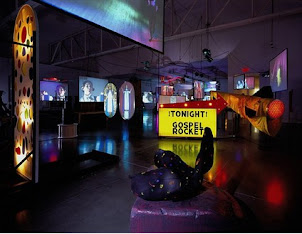No. 6 - Report - Mike Kelley

Unisex Love Nest (1999), a parent's static idea of their child's gender - polarized, cutified, idealized, simulated and projected.
"I’m an avant-gardist. We’re living in the postmodern age, the death of the avant-garde. So, all I can really do now is work with this dominant culture and flay it, rip it apart, reconfigure it, expose it— because popular culture is really invisible." --Mike Kelley

Unisex Love Nest (1999), a parent's static idea of their child's gender - polarized, cutified, idealized, simulated and projected.
Mike Kelley (b. Detroit 1954 - d. Los Angeles 2012) was a conceptual artist (not sure how he'd feel about that label, though) whose application of the punk attitude 'by all means necessary' to his artistic practice makes his work hard to categorize within strictly material terms.
 |
Banana Man 1983 |
 |
Eviscerated Corpse, from the "Half a Man" series |
"the stuffed animal is a pseudo-child, a cutified sexless being which represents the adult’s perfect model of a child—a neutered pet" (4).
The stuffed animal to him is a hyperreal state of being projected onto a child by means of a toy meant for enjoyment, with most other childhood decoration and objects doing this same neutering and projection of gender polarities (gender fluidity being a early interest of Kelley's). His stuffed animal series "Half a Man" explores this with stuffed animals being placed in sexual positions--ambiguous and explicit, establishing a strong importance of impression, rather than pure object admiration--and sewn together to create hypersexualized creatures giving birth, spilling their guts out, etc. (5).
Kelley's work with low-end culture material (with a semi-readymade approach) exemplifies his interest with mining pop-culture, focusing on the prolific parts of popular culture and capitalism's grip on it (production of products) which other artists who mine popular culture, such as Andy Warhol, focused only on the high-end of. Combined with his performance work, writing, video, drawings, and craftwork, Kelley's approach to new media is truly new media because it creates no boundary between the soiled stuffed animal and the essays and videos which accompany (and are) his works.
 |
Ahh...Youth! (1991) ('Mugshots' of stuffed animals and Mike Kelley yearbook photo, |
His later works involved more installation, video, and performance, as well as drawings and other crafts. The 2005 comprehensive installation piece "Day Is Gone", which was never 'completed', is series of videos, performances, soundtracks, and other works which deconstruct and rearrange many very American performance types/characters and puts them into a framework of historical tropes. This series feels like a culmination of all his previous work, with themes running through all of them clearly. This and previous works, such as his full-room installations reframing institutional settings, focus on things and concepts directly in the hyperreal simulations of pop-culture:
"[People are] not taught to look at films and recognize them as things that are put together. They see film as a kind of nature, like trees" (3).
 |
Day Is Done (2005) (a sea of symbols/performances,reconfigured and bombarding you - dizzyingly familiar) |
"I’m an avant-gardist. We’re living in the postmodern age, the death of the avant-garde. So, all I can really do now is work with this dominant culture and flay it, rip it apart, reconfigure it, expose it— because popular culture is really invisible" (3).
 |
Educational Complex (1995) |
 |
Mobile Homestead (2005-2013) |

Comments
Post a Comment